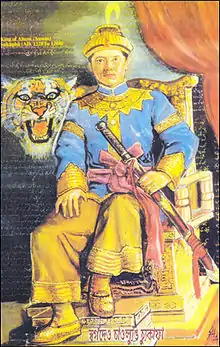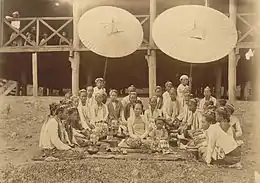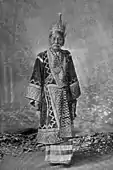Chao Pha
Chao-Pha (lit. 'lord of the sky'; Tai Ahom: 𑜋𑜧𑜨 𑜇𑜡, Assamese: স্বৰ্গদেউ, Thai: เจ้าฟ้า, Shan: ၸဝ်ႈၾႃႉ, Burmese: စော်ဘွား, Chinese: 蘇巴) was a royal title used by the hereditary rulers of the Tai peoples of Mong Dun, Mong Shan, Mong Mao, kingdoms of Mueang Thai and Tai-Khamti people. Chao means "Master" or "Lord", and Pha means "Sky" or "Heaven". According to local chronicles, some fiefdoms of Chao-Pha date from as early as the 2nd century BCE; however, the earlier sections of these chronicles are generally agreed to be legendary.
| Chao Pha | |
|---|---|
 | |
| Last holder | Chao Pha Purandar Singha |
| Status | Not used in Modern days |
| A Tai Nobility Title used by Ahom Kings, Shan Chiefs, Thai Prince / Princess and Khamti Chief. | |
Overview
During British colonial rule, there were 14 to 16 Chao-Phas at a time, each ruling a highly autonomous state, until 1922 when the Federated Shan States were formed and the Chao-Phas powers were reduced. However, they nominally kept their positions as well as their courts and still played a role in local administration until they collectively relinquished their titles in favour of the Union of Burma in 1959.[1]Shan is the semi-independent Shan States (Mong, Shan: မိူင်း, pronounced [mə́ŋ]) in what today is Eastern Myanmar (Burma). It may also be used for rulers of similar Tai/Dai states in neighbouring countries, notably including China's Yunnan Province.[1]
Gallery
- Pictures of Chao Pha
See also
References
- Donald M. Seekins (2006). Historical Dictionary of Burma (Myanmar). Scarecrow Press. entry Sawbwa, p. 391.
_at_the_Durbar%252C_Delhi%252C_India.jpg.webp)

